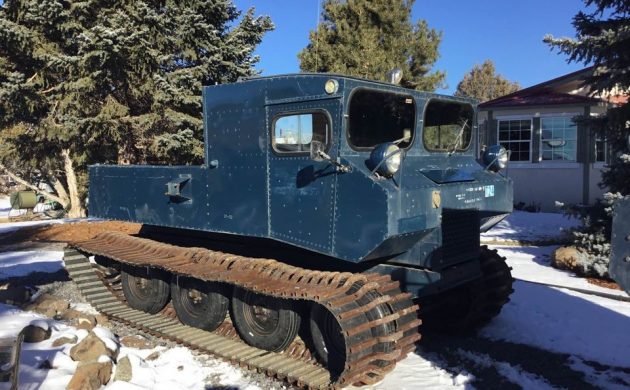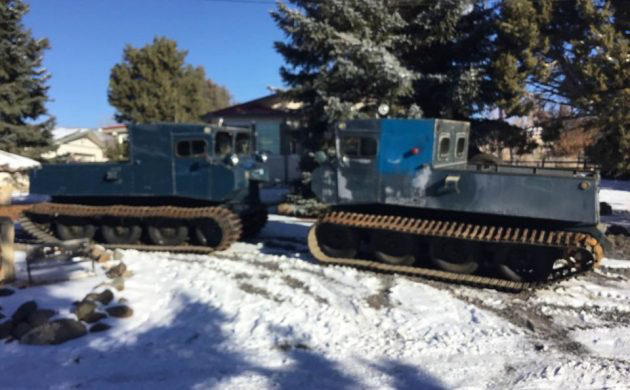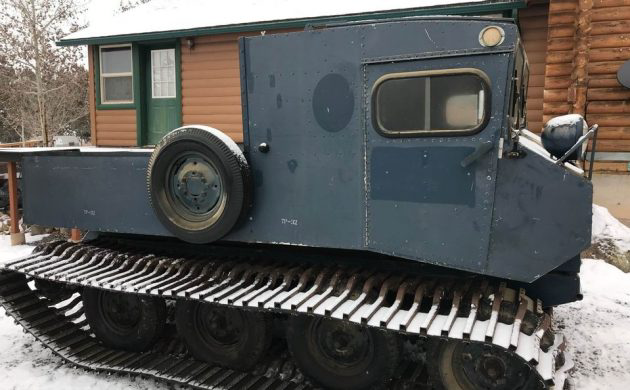Given the brutal cold blanketing parts of the country today, a snow machine that can blast through the worst Mother Nature can offer seems downright appealing. For whatever reason, the information on this pair of Thiokol Snowcats isn’t loading on the classifieds listing, but you can get the gist of what’s up for grabs: a dynamic duo of the finest snow machines ever made, known for taking researchers and soldiers far into the depths of Antarctica without breaking a sweat. Thanks to Barn Finds reader Jonny C for sending this in, and check out the listing here on Facebook Marketplace.
Again, I apologize for the page not loading correctly if you encounter the same issues that I have, but hopefully it’s isolated to my device. Anyhow, the snow machine industry is surprisingly diverse for what seems like a niche vehicle, but you don’t have to look too far to see how many companies were getting on the business of building all-terrain vehicles that could scale an iceberg back in the 50s and 60s. In fact, the name “Snowcat” doesn’t even seem to be owned by any one brand, and is more of a generic term for describing a vehicle with tank-like tracks and a cabin with a heater. These were blunt instruments that weren’t very good at anything other than plowing through deep snow.
The construction was laughably crude, effectively a hodge-podge of parts and metal sheets, whatever was necessary to provide some sense of comfort. The drivetrains were typically pulled from domestic pickup trucks, ensuring that the lack of refinement continued into the engine compartment. However, when you look at the purpose of rigs that companies like Thiokol built, your maximum comfort wasn’t a concern. Getting up and over the mountain was, or rescuing stranded skiers, or finding victims of a plane crash huddled in a mountain cave. Today, these vintage Snowcats have found a second life of sorts as period-correct accessories for folks who live for the mountain life, or have found a way to ski every day and get paid for it.
What’s fascinating to me is how companies like Thiokol got their start: according to BestRide.com, the ski industry was booming after World War II. Companies were racing to grab contracts for building chair lifts and rope tows for getting up and down the mountain, and Thiokol was one of those entities that was slinging up telephone poles on mountains as quick as they could. Seeing the potential of building machines that could help service the equipment and survive on the mountain, the idea to build a snow machine like this was born. What could you use this for today? It all depends on where you live, as they aren’t cut out for roadways or tight spaces. If you own some land in Montana or reside off the reservation in Maine, this could be the rig for you.











I used to see these sitting everywhere now not so much . They used to be cheap and again not so much. I acquired mine in Basalt Colorado it had been sitting on a 1965 Chevrolet 2-1/2 ton flatbed for 12 years since the owner passed away. They are certainly Spartan in options but reliability and 2 good heaters in mine are awesome. My Thiokol T10 carries pilot,copilot and 8 crew…..the taller you are the more challenging in confined space…..but to get to our cabin at 10000 ft in Gunnison Colorado she is worth every penny
I used to see these sitting everywhere now not so much . They used to be cheap and again not so much. I acquired mine in Basalt Colorado it had been sitting on a 1965 Chevrolet 2-1/2 ton flatbed for 12 years since the owner passed away. They are certainly Spartan in options but reliability and 2 good heaters in mine are awesome. My Thiokol T10 carries pilot,copilot and 8 crew…..the taller you are the more challenging in confined space…..but to get to our cabin at 10000 ft in Gunnison Colorado she is worth every penny
Wish I could figure out how to send a picture of mine on here she’s a beautiful beast
If my memory serves me, wasn’t one of these type of machines in the movie ‘The Shining’?
Would these work on the beach?
Thiokol Imp or Sprite was used in The Shining.
These look like ex Air Force vehicles. We had some at Grand Forks Air Force, N Dakota. When nothing else would move in blizzard conditions these would go anywhere.
Same at F E Warren AFB and most likely at all Minuteman missile launch control centers in the western US.
Yes we also had one – the full cabin type, when I was in the Air National Guard in northern Michigan. Ours was registered as a 1967.
Those pictures bring back memories. I was working for a Canadian military research lab in the early seventies that had one of these at our camp in the high arctic about an hour’s flight in a Twin Otter east of Resolute Bay. If I remember it had a Ford six and a NiCad battery so it would always start after sitting for months.
A write-up is composed of almost entirely incorrect information. The “Sno-Cat” name was trademarked by the Tucker Sno-Cat Corporation in 1946. Tucker Sno-Cats use domestic pickup truck drivetrain. Thiokols do not. Snow cats were a very, very small part of Thiokol’s business, as they were mostly in heavy industry aerospace. The snow cat division was sold to DeLorean in 1978.
All of this information was found in about two minutes of Googling. It’s like the writer just sort of made everything up and did no research at all. Lame.
Used to be my favorite red matchbox back in the day. Had two matter of fact & the tracks kept coming off.
Jeff, its not your computer, the Facebook info won’t load for me either. I’m wondering if these may have been once Air Force surplus judging by their color and where the emblems and lettering that are painted over on the doors. They look like they would be a lot of fun as long as you did’t break it or bury it way out in the middle of nowhere. Maybe that’s why they had two of them!
Hi, I am the guy who originally placed this ad to n FB in Colorado. The painted over decals was North Dakota game and fish. Underneath them and inside the cat, as well as outside, were several painted letters and numbers indicating these machines were used by the Air Force. They were set up for extreme cold, with several add ons in them for this, including two heaters. I bought these two from Minnesota outdoors, along with a third one, they hadn’t been started up in over 15 years. They all fired right up. I sold two of them, one here in Colorado and another went to CA. I still have a 1202B and purchased a 1968 Spryte. All are awesome classics with tons of character. They really were barn finds as they sat in a pole barn and were caked with dust. My Spryte was purchased from a power company in NB. They bought it new in 68 it was always garaged at their shop. It is a beast and it’s in excellent shape! I use it to access my cabin at 11,200 feet up. Always gets a smile and thumbs up.
not enuff info here or on the orig site. I hate FB Mrkt Pl.
One step better than the ‘sled’ (sno mo bile) but the aficionado goes w/the modern variants “Sherp”. I like the Thiokol simply for the car tires. Looks easy to change out w/the seasons. Skips answ is “Yes. Either this way or w/the tires only, deflated a bit.” Due to the nature of the mo-chine I feel I should advise: PLEZ stay on trails, do not break down stream banks, use willy-nilly. Our environment took yrs to develop as it has. U can destroy it (& have ramifications far beyond that immediate area).
we had one at the ski resort I worked at they said you could run over a person andnot hurt them
I thought Tucker was a Snowcat,,,turns out, Tucker is Sno-cat, and pretty much the same thing, and as mentioned, all tracked vehicles became known as “Snowcats”. I read, I believe this is a model 601, these were powered by a Ford 240 ci in line six and a 4 speed trans. I found several pics of these being used by the USAF, so that would explain the color. Not much could stop them, and design hasn’t changed much even today. They will go through anything,,,except this. ( Tucker shown on Arctic expedition).
https://fi.pinterest.com/pin/522699100498289392/
Oh, one more thing, does the name “Thiokol” ring a bell? The failed O rings that caused the Challenger disaster were made by Thiokol.
your correct Tucker is the sno-cat they were a very good machine I liked them better than the Thiokol .
Howard,
You are very close, it was Morton Thiokol division that created the seal problem.
Yea, Morton Thiokol made the o-ring that failed in the Challenger – after explicitly telling NASA NOT to launch that cold January day. NASA chose to ignore the warning.
I think the guy that told them not to launch ended up killing himself.
Howard A – I’m not sure about that but in my first job out of college I worked with a guy that had previously worked at MT and was there when the shuttle blew up. He said it was miserable. The Government/NASA was trying to pin the explosion on them and they all had to dig out all the evidence to prove that they had warned NASA about not launching when it was that cold outside.
In the end, I don’t think MT was ever ‘fined’ or had to pay any monetary penalty – because they made the o-ring use criteria clear. It was NASA that ignored the warnings.
Neil, You are quite correct.
Howard, I have heard the same thing many times, and that was what I thought as well. But a voice in my head said to research this claim, and I did.
So guys, here is what I found on NASA’s own publication, “Researcher News” . . . .
https://www.nasa.gov/centers/langley/news/researchernews/rn_Colloquium1012.html
Great article! Here’s another one about the management culture at NASA that caused it.
The Challenger disaster teaches leaders to face the brutal facts of reality
Sunday, Jan. 28, marked the 35th anniversary of the space shuttle Challenger disaster. On that date in 1986, the Challenger exploded 73 seconds after liftoff due to a leak in one of the O-rings of the solid rocket booster, resulting in the death of all seven crew members and the loss of the shuttle.
On this occasion, I would like to look back to an article I wrote two years ago, on the 30th anniversary of the Challenger disaster, that emphasizes the importance for all leaders of surrounding themselves with and listening to independent thinkers who will help them face the brutal facts of reality.
The engineers at Morton Thiokol, the contractor responsible for the design of the solid rocket boosters, were concerned about the cold temperature on launch day and the effect the cold would have on the solid rocket booster O-rings. The O-rings were designed to operate at an ambient temperature of not less than 40 degrees Fahrenheit.
On the day of the launch, the ambient temperature was 30 degrees. Concerned about the brittleness of the O-rings, Thiokol told NASA that the launch needed to be postponed.
NASA objected to the recommendation to delay the launch. The launch had already been delayed a number of times for various reasons. One NASA manager is quoted as saying, “I am appalled by your recommendation.” Another NASA manager said, “My God, Thiokol, when do you want me to launch – next April?”
NASA made unrealistic launch frequency commitments to Congress to secure increased funding for the space program. Thiokol management, facing pressure from NASA, eventually acquiesced and agreed that the launch could proceed. The rest is history. The United States lost the Challenger and its crew due to the catastrophic failure of an O-ring.
On January 28, 2016, columnist Howard Berkes wrote an article for the NPR publication “The Two-Way” headlined “30 years after explosion, Challenger engineer still blames himself.” For his article, Berkes interviewed Morton Thiokol engineer Robert Ebeling, who told the story of how he and four other engineers did not want the Challenger to be launched due to cold weather conditions. In spite of their concern, NASA launched the shuttle anyway.
Ebeling told Berkes, “‘I was one of the few that was really close to the situation. Had they listened to me and wait[ed] for a weather change, it might have been a completely different outcome. … [NASA] had their mind set on going up and proving to the world they were right and they knew what they were doing. But they didn’t.’”
For the remainder of his life, Ebeling blamed himself for not being able to convince NASA to delay the Challenger launch. I had the privilege of speaking with Ebeling shortly after the 30th anniversary of the Challenger disaster. I told him that he and the other Thiokol engineers who warned against the launch were American heroes. Ebling passed away two weeks after my conversation with him.
Many times, a decision will come down to assessing the risks of various courses of action. When the possible result of a course of action is catastrophic even if the probability of it occurring is low, one should not take the risk. Unfortunately, the NASA decision makers who moved ahead with the Challenger launch did not think in these terms. They were more worried about their unrealistic launch schedule commitment to Congress.
Leaders need to create an environment and institutional culture that welcomes and encourages individuals to share their opinions. A courageous independent thinker should voice their opinion and try to convince everyone of the validity of the organization’s reality. The views of the independent thinker may not be ultimately adopted, but at a minimum, those views provide a different path, a path against which the majority opinion can be tested and either confirmed or changed. Under this type of process, the best decisions will emerge.
In the words of renowned Brazilian novelist, Paulo Coelho, “If you want to be successful, you must respect one rule: Never lie to yourself.” Leaders: Remember this when one of the independent thinkers on your staff reminds you to face the brutal facts of your reality.